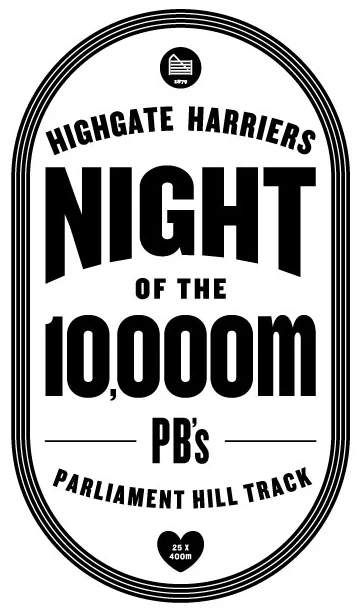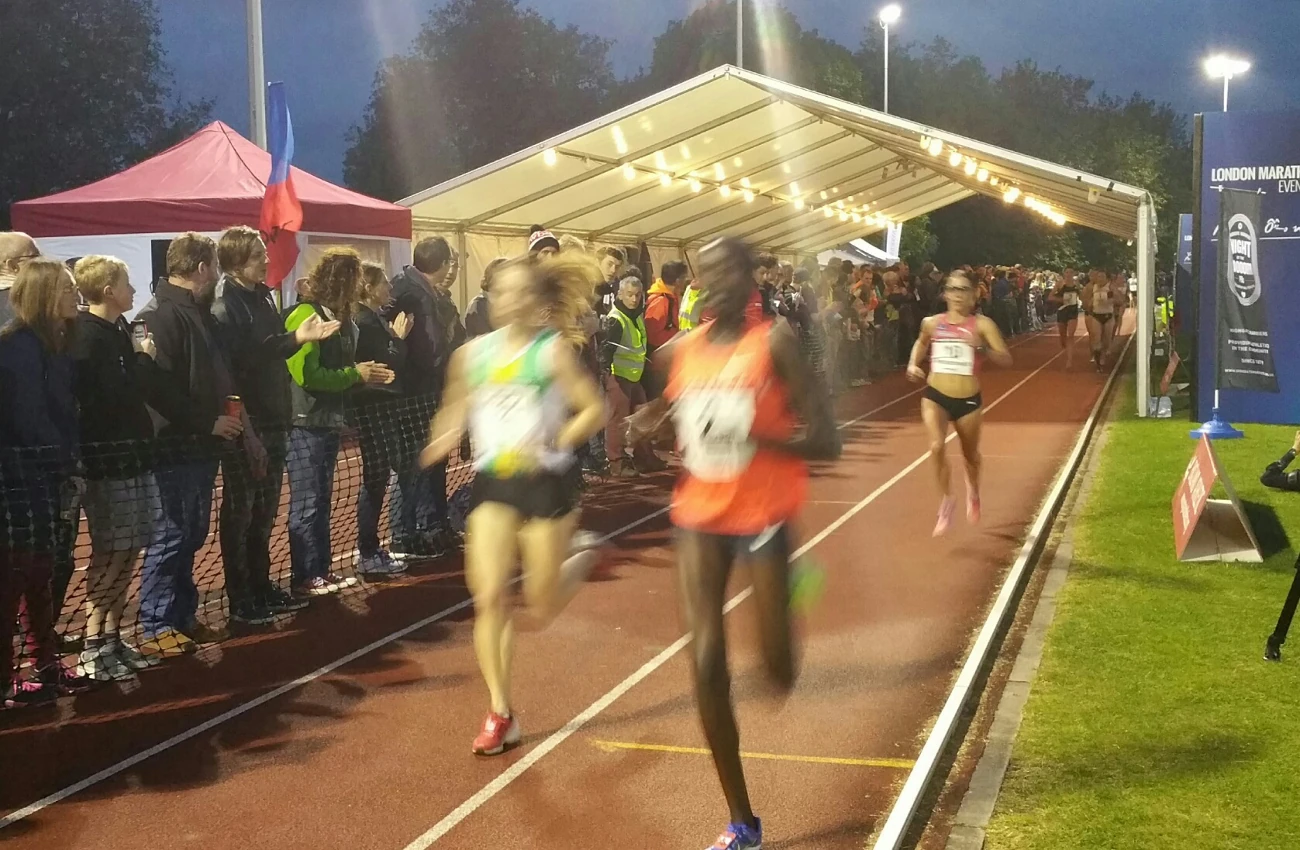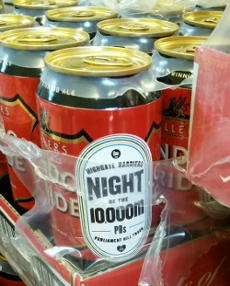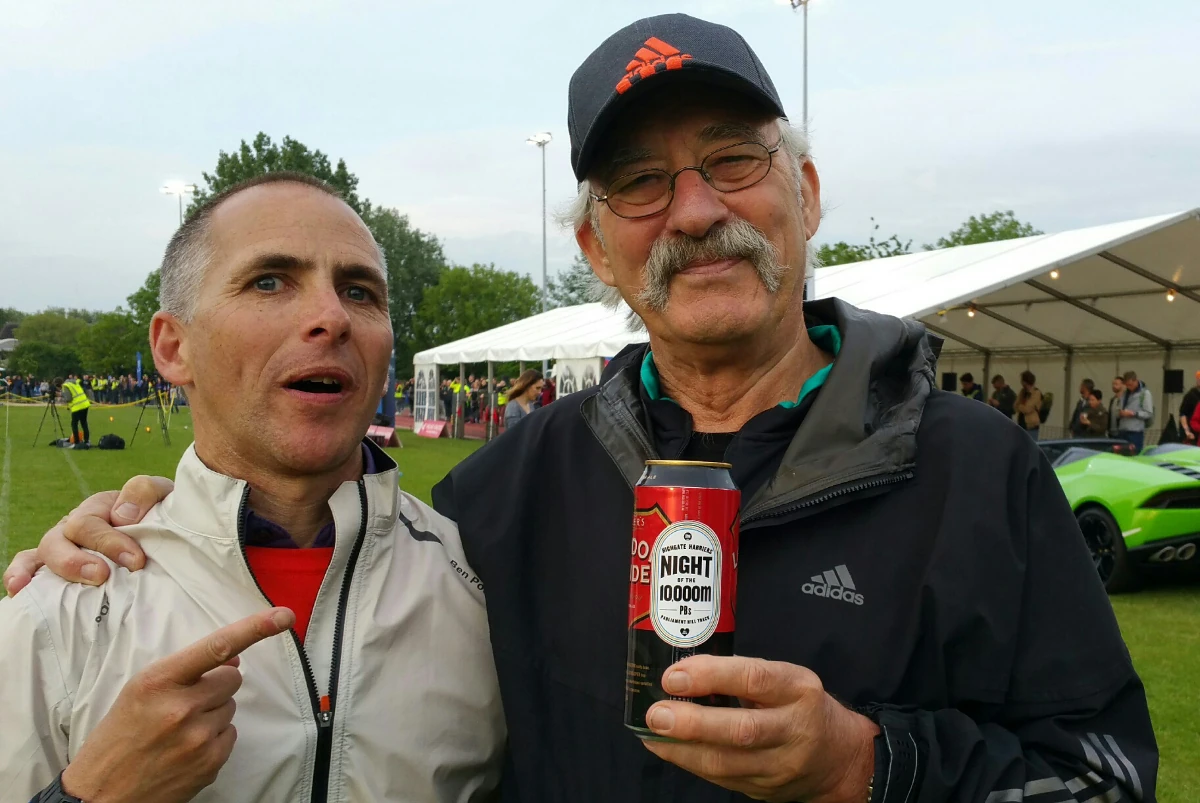Ben Pochee - Highgate Harriers Night of the 10,000m PBs

We speak to Ben Pochee, organiser of Highgate Harriers Night of the 10,000m PBs, a fast-growing event started in 2013 that brings together some of the finest distance runners in the country and lets them battle it out over 25 laps of the track.
We discuss the problems with 10,000m racing, what goes into organising such a massive event for free, world-class athletes, the wonder of athletics officials and volunteers, and Chas 'n' Dave.
The Interview
We spoke to Ben in December 2016
rb: We’re sure the readers have a pretty good idea from the title, but what essentially is Night of the 10,000m PBs?
bp: Night of the 10,000m Pbs is essentially a special blend of track meeting and spectator event with a festival feel, specifically for 10,000m racing. I suppose that in essence is what it is.
rb: And what was your motivation for creating it? There are already lots of track events around, surely?
bp: We created it because we really felt there was a distinct lack of racing opportunities over that distance for top-level club athletes and elite athletes to all race together and push each other on.
“Could we turn the ugly duckling of track events into something a little bit more sexy?”
There are 10,000m races already of course, but you usually get something like 10-15 people of massively disparate ability all over the track, with nobody helping anybody else along. That’s basically a time trial that’s not fun for the runners or the spectators
So, the question was, could we do things differently? Could we turn the ugly duckling of track events into something a little bit more sexy?
Could we make it not only a top event for the runners, but also something different – and special – for the spectators. An event that people pro-actively wanted to come and watch and get involved with and then in turn create an atmosphere to help the athletes race better and run personal bests.
rb: Was the lack of quality races something you noticed yourself or were people actively bemoaning the fact?
bp: It seemed to me that a lot of people just accepted that that's the way things are, and maybe even started thinking that there's no passion for the event. So race organisers would think "why bother to put them on?".
Luckily, that's clearly not the case because of the interest we get at our event.
rb: How confident were you that there was a demand before the first event?
bp: At first I didn’t really know how it would pan out and it was a bit of a shot in the dark, but I just thought there had to be at least an opportunity for someone to put on an event and to try and get a group of decent runners together in one place.
And to let the runners know that there would be other quality athletes there. It can become a bit of a vicious cycle otherwise. If nobody knows anybody's running then they don't want to run or drop out, so I tried to make the whole thing very transparent. Show exactly who would be running and then keep confirming with the athletes. Historically there has been a problem with 10,000m events that people drop out.
For the first event in 2013 all I really wanted was to secure a really good event where there were 25-30 people racing each other in a really competitive track 10k.

rb: And how did it go?
bp: Great! I think we had two or three races and Ed McGinley came down from Ireland and ran sub-30. That was a real landmark.
We had a crowd of maybe 50-75 people and some amazing officials. I'm so grateful to those people that committed to the first event because that gave us the little bit of momentum we needed to really start cranking things up later on.
rb: And you hosted the Olympic Trials for Rio last year, so it's safe to say the event has grown since 2013?
bp: Yes, we had about 5,000 people last year. There was a big PA blasting out tunes, a 30-metre long marquee with a booze bar that the runners ran through, and massive crowds cheering on from lane three.
rb: Lane three? This sounds interesting...
“Traditional athletics is almost Victorian in a stoic, calm, polite, one-person-clapping way, with everybody 50 metres away from the action.”
bp: Well, we've always assumed that you go to an athletics meet and everybody is way back from the track and that's the way things are.
So I had to ask myself if we could do things differently. Then I had to check all the regulations with the IAAF and UKA and that we weren’t contravening any rules.
Traditional athletics is almost Victorian in a stoic, calm, polite, one-person-clapping way, with everybody 50 metres away from the action. It’s so hard to generate something atmospheric to get the emotion going with that set-up.
rb: And being closer to the action does the trick?
bp: Well, when Jo Pavey came in 2014 she said the crowd was louder then the Olympic final she did at London 2012, just because of the proximity. I mean, the crowd are only about 30 centimetres away from her face, so I'm not surprised.
rb: Decent feedback! Just how important do you think that atmosphere is?
bp: Very. When I was racing I always did best when there was a really emotionally-charged atmosphere. When I was at road relays and friends and team-mates were standing close to the path cheering me on, I was always able to get so much more out of myself.
I don’t know how you quantify it but just look at all the training we do as runners and all the marginal gains we get by having the right footwear and doing the right stretching and so on. I just think that the whole area of emotion and atmosphere is very rarely looked at in terms of a performance gain. It'd be a really interesting study.

rb: Speaking of atmosphere, I know you put on more than just the races, don't you?
bp: Yes! So, a big part of the attraction for spectators is of course coming - for completely free - to watch some of the best athletes in the country come and chase their World Champs or Olympic Dream.
But on top of that we're trying to create an event where you can come and have almost no experience of athletics but take advantage of huge amounts of entertainment.
So, we have two licensed bars on the track. We have live music, dancers and other entertainers. For example, last year we had a fire juggler. We have food available and a whole range of other promotional stuff going on from sponsors as well.
We're always looking at what worked in the past and how we can provide even more and improve on it.
rb: So what are the plans for 2017 in terms of entertainment?
bp: Well, we're due to announce that the IAAF president Lord Seb Coe will come to our event in 2017, because the big thing for next year is that we'll be incorporating the GB trials for the World Championships.
“We're going to have pie 'n' mash and have already booked a Chas 'n' Dave cover band called Daz 'n' Chave.”
And the World Champs will be taking place in London's Olympic stadium, so there's a really lovely London 2012 link and narrative for the legacy in terms of our event. He has reliably informed me that he'll definitely be there after the success of the 2016 event.
With the link to the World Champs being held in London next year I need to put my thinking cap on and get a proper London theme going.
We're going to have pie 'n' mash and have already booked a Chas 'n' Dave cover band called Daz 'n' Chave
And more stuff for kids, maybe circus entertainers.
Basically the idea is that the whole family can come down, and if you're not watching athletics then you'll be listening to something amazing, eating something amazing, or being dazzled by the various entertainment. And at the same time Mum and Dad can have a drink.
Basically a funfair festival, with an athletics event going on in the middle.
rb: In terms of the actual racing, what's been your favourite so far?
bp: The first thing that springs to mind is the amazing women's race this year where Jess Andrews appeared from almost nowhere. She'd been living out in Spain and came over for the event.
We had the 2011 World Champion, Linet Masai, in the race. She was running ostensibly to get the Olympic qualifying time, but got beaten by Jess Andrews.
We're becoming one of the bigger races in Europe for those people looking to get global championship qualifying times. There are very few track races where elite women can compete; where enough of them come together to push each other on and you get that density of quality to really go for quick times. I was really chuffed to bits with the women's race this year.
To give you an idea of the depth, sixth place in the race was running 32:32. We had Kate Avery in 5th place with 32:11, Linet Masai with 32:02 and Jess Andrews was sub-32.
Then in the men's race we had Ross Millington running 28:28 and of course he went to Rio along with Andy Vernon.
rb: How important that that depth of quality?
bp: Very. Let's say you're aiming for sub-32 as a man, you want 10 or 15 guys around you going for a similar time.
Or if you're a woman trying to break 37 minutes, you don't want one or two women around you going for sub-37, you want a big group.
So, that's really what we're really looking for, to create a real depth of quality at this event. So whatever goal you're going for, there's a huge group of people all working together and all pushing each other on to achieve the times. Because that's the only way it happens.

What I'm really hoping is that the women's and men's races at the top end really attract a bit of talent from Europe, which then bolsters that depth of quality and then filters down to all the development races. So that they all have enhanced quality.
It gives confidence. Once they see the event has that depth it becomes a self-fulfilling prophecy. I mean, I'm not expecting a bunch of East Africans to rock up and run 26 minutes. It's really about helping the Brits run qualifying times, and I think we can definitely do that by getting some International quality propping up the events.
rb: How many different races do you put on?
bp: We have six. We are limited by how many we can put on because of logistics, and of course the fact that you're relying on officials and volunteers and there's a limit to how long you can ask them to spend.
I'd love to put on more races, but that's the difference between the track and the road. At a road event you can have 500-600 runners with no problem, but on the track it's a different kettle of fish.
However, this year we're hoping to add one additional race for women looking to get times from 37 to 40 minutes. So, basically a sort of development race for women that are looking to make the step up.
rb: Presumably with limited spaces there are qualifying times?
bp: Yes, you do need a qualifying time. As the event's become more popular the quality has gone up and therefore our qualifying times have gone up to try to manage that and ensure the best quality. Because as much as we try to be inclusive, it is an elite development event.
“I just want Brits running much faster.”
That's obviously an elite thing to say, but I just want Brits running much faster, which sadly means that we can't invite everybody since we're limited by how many we can have on the track if we're running 6 or 7 races.
But the nice thing is that there are other 10,000 metre races that have bubbled up off the back of this event. For example, Orion Harriers put on an event in June called Fast Friday. They have several 10,000 metre races that tend to cater for those that just miss out on getting to our event.
rb: What's remarkable is that all this is put on for free. Where do all the volunteers come from and how are costs covered?
bp: A lot of it's down to our sport. The beauty of our sport is that so many people are willing to volunteer.
We have about 200 volunteers on the day. Officials, marshalls and so on. I do it purely as a volunteer and we have loads of people from my club, Highgate Harriers, and other clubs stepping up to help out.
Athletes who want to run have to pay a £15 entry fee, and that helps pay for some of the basic stuff. Then it's my job to get commercial sponsors on board who are prepared to provide some funding that goes towards the infrastructure.

This year we had a huge double-sided screen and a camera crew who donated their time.
The screen alone was £8,000. A fantastic company called X-Bionic - a clothing firm - helped fund that.
London Marathon Events & City of London Corporation have been two of our most generous partners over recent years and we're hugely grateful for their support.
Then we had a 30-metre marquee, which would cost about 3-4 grand. We had a company called Marquee Magic essentially providing it for cost, which made it doable.
HSS Hire - a wonderful tool hire company - provided a cherry picker lift, which we used for various things. They also provided a couple of generators.
Additional commercial partners include Islington Council who helped provide our digital VMS display signs to advertise the event to the local community, Soar who provide our back straight DJ & online play lists, Superwire who create the ongoing design work, Fullers who who ensure our beer tent prices are kept very low, The London Trophy Company who provided over 3,000 bespoke pin badges we gave out free, Like the Wind magazine who created our programme, The Running Works store who have helped with pacers and offering rare retail kit deals to our spectators, not forgetting MyProtein who have been our energy drinks partner. The list of event partners who've helped make it happen goes on & on!
It's a time-consuming process, but a lot of it is reaching out and talking to people.
rb: Is it just you organising things or do you have a team?
bp: It's mainly me on a day to day basis but over the years more people from Highgate Harriers have taken on supporting roles which has proved invaluable.
On the day there's a whole army of guys helping out. That's what I love about our sport. It's a competitive sport and there is of course inter-club rivalry, but all those clubs are filled with members who all understand the ethos of our sport and what makes things happen. So many of them come together to make the event what it is.
There are probably 200 people to thank and I wish I could list them all now.
The event is amazing, but what is truly amazing is the collaborative effort and all the good will. It's really special to be part of it and witness how many people are willing to come together.
rb: Before we wrap up, there is one last question we ask all our interviewees. If you could race against, and beat, any athlete from any era in any race. Who, when, where, what would it be?
bp: I think it would have to Emil Zátopek. He was one of the earliest superstars of the endurance game.
He was famous for not looking beautiful when he ran. He had this grinding style. It looked like he was running through a tunnel of grime.
Assuming he was on cinders and I was in my prime... I think I'd love to run against him in the Helsinki Olympics, when he won the 5,000m, the 10,000m and the marathon.
rb: Need we ask which of the three you'd choose?
bp: I think I have to say the 10,000m, don't I?
rb: How would the race pan out then?
bp: Let's say I'm about 19, 20 years old when I still had a bit of a kick. I quite like the idea of sitting on him and then our-kicking him with 150 to go.
There'd be the contrast of styles. Me all youthful and flowing and Emil with his agonised style.
They probably didn't have very sensitive equipment back then, so let's say I beat him by two-tenths of a second. And maybe even throw in a cheeky Ovett wave!
I would happily lose to him though. I just love the idea of running with him. In reality he'd kick my arse!
rb: Your wish is granted. Ben, thanks so much for taking the time to talk to us. Good luck with your preparations for the big night. We're sure it'll be another massive success and we look forward to seeing you there.
Ben is a coach at Highgate Harriers and director of running specialist wellbeing company LGN Wellbeing. You can keep up with him on Twitter.